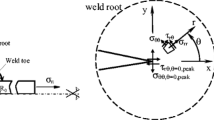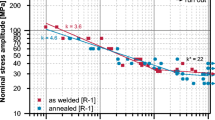Abstract
It was shown in previous papers that in plane problems the elastic tangential stress and the elastic shear stress evaluated at the weld toe or at the root of fillet-welded joints by means of a finite element analysis, with a well-defined pattern of elements, are proportional to the mode I and mode II Notch Stress Intensity Factors (NSIFs), respectively. On the basis of such properties, the so-called Peak Stress Method (PSM) is a simplified, finite element-oriented application of the N-SIF approach to fatigue analysis of fillet-welded joints with un-machined weld seams. In the present paper, the PSM is extended to torsional loading conditions, which induce mode III stresses at the weld toe and at the weld root. First, it is shown that the finite value of the elastic anti-plane shear stress evaluated at the weld toe by means of a finite element analysis is directly proportional to the mode III N-SIF. Afterwards, taking advantage of the strain energy density criterion, an equivalent local stress is derived. Finally, a synthesis of experimental results of fatigue tests on tube-to-flange fillet welded joints subject to torsion loading and failing either from the weld toe or from the weld root is presented.








Similar content being viewed by others
References
Lazzarin P, Tovo R (1996) A unified approach to the evaluation of linear elastic fields in the neighbourhood of cracks and notches. Int J Fract 78:3–19
Lazzarin P, Tovo R (1998) A notch intensity factor approach to the stress analysis of welds. Fatigue Fract Eng Mater Struct 21:1089–1103
Atzori B, Meneghetti G (2001) Fatigue strength of fillet welded structural steels: finite elements, strain gauges and reality. Int J Fatigue 23(8):713–721
Lazzarin P, Livieri P (2001) Notch stress intensity factors and fatigue strength of aluminium and steel welded joints. Int J Fatigue 23(3):225–232
Williams ML (1952) Stress singularities resulting from various boundary conditions in angular corners of plates in extension. J Appl Mech 19:526–528
Qian J, Hasebe N (1997) Property of eingenvalues and eingenfunctions for an interface V-notch in antiplane elasticity. Eng Fract Mech 56(6):729–734
Gross R, Mendelson A (1972) Plane elastostatic analysis of V-notched plates. Int J Fract Mech 8:267–272
Meneghetti G, Lazzarin P (2006) Significance of the elastic peak stress evaluated by FE analyses at the point of singularity of sharp V-notched components. Fatigue Fract Eng Mater Struct 30:95–106
Meneghetti G (2012) The use of peak stresses for fatigue strength assessments of welded lap joints and cover plates with toe and root failures. Eng Fract Mech 89:40–51
Sonsino, C. M. (1997). Fatigue strength of welded components under complex elasto-plastic, multiaxial deformations, Report EUR 16024 DE, 1997; Also LBF Report N. 6078 1994.
Yousefi F, Witt M, Zenner H (2001) Fatigue strength of welded joints under multiaxial loading: experiments and calculations. Fatigue Fract Eng Mater Struct 24:339–355
Amstutz H, Störzel K, Seeger T (2001) Fatigue crack growth of a welded tube-flange connection under bending and torsional loading. Fatigue Fract Eng Mater Struct 24:357–368
Seeger T, Olivier R (1987) Tolerable and allowable shear stresses at fatigue loaded welded joints. Stahlbau 8:231–238 (in German)
Seeger T, Olivier R (1992) Slope and knee-point of the S-N curve of shear loaded fillet welds. Stahlbau 61:137–142 (in German)
Yung JY, Lawrence FV (1989) Predicting the fatigue life of welds under combined bending and torsion. In: Brown MW, Miller KJ (eds) Biaxial and multiaxial fatigue, EGF 3. Mechanical Engineering Publications, London, pp 53–69
Siljander A, Kurath P, Lawrence FV (1992) Non proportional fatigue of welded structures. In: Mitchell MR, Landgraf RW (eds) Advances in fatigue lifetime predictive techniques, ASTM STP 1122. American Society for Testing and Materials, Philadelphia, pp 319–338
Razmjoo GR (1996) Fatigue of load carrying fillet welded joints under multiaxial loading. Fatigue core research from TWI. Abington Publishing, Abington. ISBN 1855735202
Lazzarin P, Zambardi R (2001) A finite-volume-energy based approach to predict the static and fatigue behaviour of components with sharp V-shaped notches. Int J Fract 112:275–298
Lazzarin P, Lassen T, Livieri P (2003) A notch stress intensity approach applied to fatigue life predictions of welded joints with different local toe geometry. Fatigue Fract Eng Mater Struct 26:49–58
Livieri P, Lazzarin P (2005) Fatigue strength of steel and aluminium welded joints based on generalised stress intensity factors and local strain energy values. Int J Fract 133:247–276
Lazzarin P, Livieri P, Berto F, Zappalorto M (2008) Local strain energy density and fatigue strength of welded joints under uniaxial and multiaxial loading. Eng Fract Mech 75:1875–1889
Lazzarin P, Sonsino CM, Zambardi R (2004) A notch stress intensity approach to assess the multiaxial fatigue strength of welded tube-to-flange joints subjected to combined loadings. Fatigue Fract Eng Mater Struct 27:127–140
Haibach E (1989) Service fatigue-strength-methods and data for structural analysis. VDI, Dusseldorf
Acknowledgments
Prof. Cetin Morris Sonsino (Fraunhofer Institute for Structural Durability and System Reliability LBF, Darmstadt (Germany)) is gratefully acknowledged for encouraging the present research, for providing experimental data and for stimulating discussion. Prof. Paolo Lazzarin (University of Padova (Italy)) is gratefully acknowledged for stimulating discussion on results obtained in the present paper.
Author information
Authors and Affiliations
Corresponding author
Additional information
Doc. IIW-2340, recommended for publication by Commission XIII "Fatigue of Welded Components and Structures".
Rights and permissions
About this article
Cite this article
Meneghetti, G. The peak stress method for fatigue strength assessment of tube-to-flange welded joints under torsion loading. Weld World 57, 265–275 (2013). https://doi.org/10.1007/s40194-013-0022-x
Received:
Accepted:
Published:
Issue Date:
DOI: https://doi.org/10.1007/s40194-013-0022-x




